Bambi (David Hand, 1942) was the fifth animated feature produced by Walt Disney. It was directed by David Hand who supervised a team of sequence directors, produced by Walt Disney and based on the book Bambi, a Life in the Woods by Austrian author Felix Salten. Creator of the visual style of Bambi was the Chinese-American artist Tyrus Wong. As his inspiration, he took the landscape paintings of the Song dynasty. The film received three Academy Award nominations: Best Sound (Sam Slyfield), Best Song (for Love Is a Song sung by Donald Novis) and Original Music Score. For this post, we combined exquisite Dutch postcards by Rembrandt publishers from the 1940s, with vintage French postcards by Superluxe and more recent postcards from Italy and Germany.
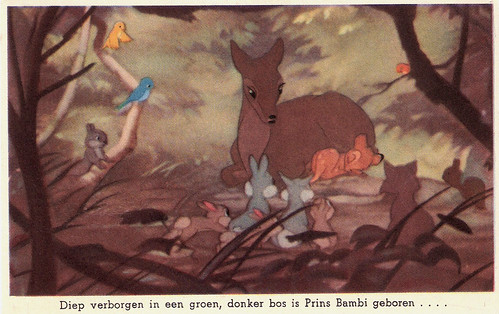
Dutch postcard by Rembrandt Uitg. Mij. Amsterdam, circa 1949. Image: publicity still for Bambi (1942). Caption: "Deep in a dark green forest, Prince Bambi is born."
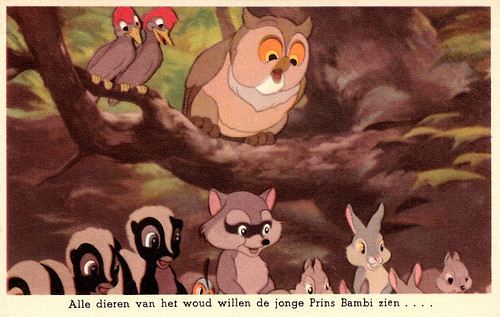
Dutch postcard by Rembrandt Uitg. Mij. Amsterdam, circa 1949. Image: publicity still for Bambi (1942). Caption: "All the animals of the forest want to see the young Prince Bambi."
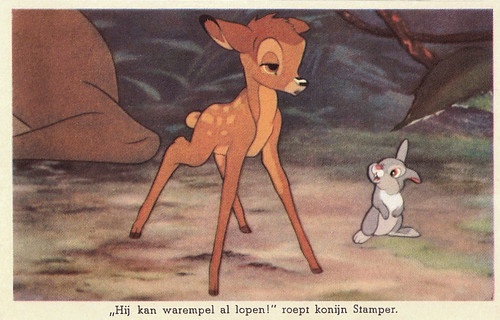
Dutch postcard by Rembrandt Uitg. Mij. Amsterdam, circa 1949. Image: Walt Disney Mickey Mouse Ltd. Publicity still for Bambi (1942). Caption: "'He can already walk!', calls Thumper, the rabbit."

Dutch postcard by Rembrandt Uitg. Mij. Amsterdam, circa 1949. Image: publicity still for Bambi (1942). Caption: "Little Thumper, what did your father say?", asks Mother Rabbit."

Dutch postcard by Rembrandt Uitg. Mij. Amsterdam, circa 1949. Image: publicity still for Bambi (1942). Caption: "Eat as many vegetables as you can, Thumper says to Bambi."
The main characters of Bambi (David Hand, 1942) are Bambi, a mule deer and his parents, the Great Prince of the forest and his unnamed mother. His friends are Thumper, a pink-nosed rabbit; and Flower, a skunk. and his childhood friend and future mate, Faline.
For the film, Disney took the liberty of changing Bambi's species into a mule deer from his original species of roe deer, since roe deer are not native to North America, and the mule deer is more widespread in the United States.
English film historian Leslie Halliwell wrote that Bambi was "one of Disney's most memorable and brilliant achievements with a great comic character in Thumper and a climactic forest fire sequence that is genuinely thrilling". He concluded his review that it was "a triumph of the animator's arts".
Hal Erickson at AllMovie adds: "In the grand Disney tradition, Bambi is brimming with unforgettable sequences, notably the young deer's attempts to negotiate an iced-over pond, and most especially the death of Bambi's mother - and if this moment doesn't move you to tears, you're made of stone (many subsequent Disney films, including Lion King, have tried, most in vain, to match the horror and pathos of this one scene).
The score in Bambi yielded no hits along the lines of 'Whistle While You Work', but the songs are adroitly integrated into the action. Bambi was the last of the 'classic' early Disney features before the studio went into a decade-long doldrums of disjointed animated pastiches like Make Mine Music."

Dutch postcard by Rembrandt Uitg. Mij. Amsterdam, circa 1949. Image: Walt Disney Mickey Mouse Ltd. Publicity still for Bambi (1942). Caption: "The rabbit friends learn Bambi how to jump."
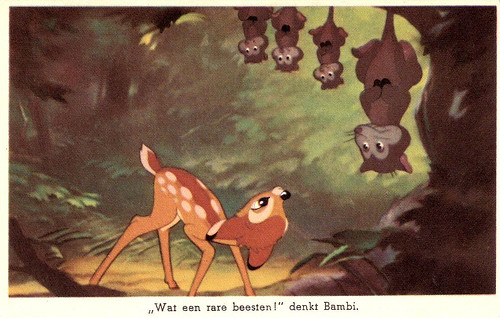
Dutch postcard by Rembrandt Uitg. Mij. Amsterdam, circa 1949. Image: publicity still for Bambi (1942). Caption: "'What a strange beasts!', Bambi thinks."
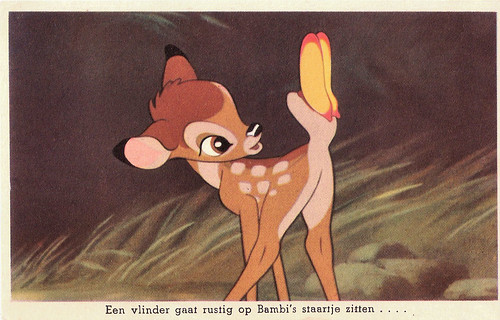
Dutch postcard by Rembrandt Uitg. Mij. Amsterdam, circa 1949. Image: publicity still for Bambi (1942). Caption: "Quietly, a butterfly lands on Bambi's tail."
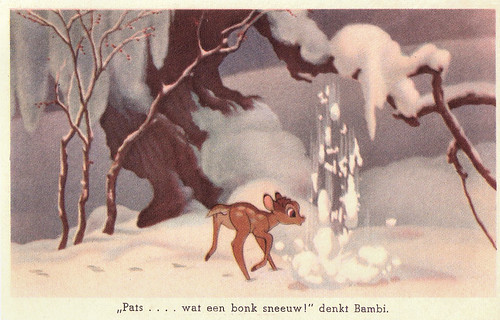
Dutch postcard by Rembrandt Uitg. Mij. Amsterdam, circa 1949. Image: Walt Disney - Mickey Mouse Co. Publicity still for Bambi (1942). Caption: "Splash... what a pound of snow!", Bambi thinks.

Dutch postcard by Rembrandt Uitg. Mij. Amsterdam, circa 1949. Image: publicity still for Bambi (1942). Caption: "Smooth Ice, huh!", says Thumper. "I'll get your legs out of the knot..."

Dutch postcard by Rembrandt Uitg. Mij. Amsterdam, circa 1949. Image: Walt Disney Mickey Mouse Ltd. Publicity still for Bambi (1942). Caption: "'You don't have to be afraid, Bambi!', says Feline, the deer girl."
Chinese-American artist Tyrus Wong (1910-2016) was the creator of the visual style of Bambi (1942). Wong, newly married and needing steady work, joined Disney in 1938 as an 'in-betweener'. He draw hundreds of pictures between poses to create the illusion of motion.
When Walt Disney began pre-production on Bambi, Wong went home and painted several pictures of a deer in a forest. Disney saw that Wong was able to produce artwork that did not necessarily look like the forest - but rather, felt like the forest.
As a staff artist for Hollywood studios from the 1930s to the 1960s, Wong drew storyboards and made vibrant paintings, as detailed as any architectural illustrations, that helped the director envision each scene before it was shot. For Bambi, he was involved with every phase of production.
Margalit Fox in The New York Times: "Invoking the exquisite landscape paintings of the Song dynasty (A.D. 960–1279), he rendered in watercolors and pastels a series of nature scenes that were moody, lyrical and atmospheric — at once lush and spare — with backgrounds subtly suggested by a stroke or two of the brush."
Tyrus Wong only worked at Disney for three years, as a consequence of the Disney animators' strike. He moved to Warner Brothers as a concept artist, designing greeting cards for Hallmark on the side. Over the years his work informed the look live-action films for Warner Brothers and other studios.
In a statement after his death in 2016, the Walt Disney Family Museum said "his influence on the artistic composition of the animated feature Bambi cannot be overstated."

French postcard by Editions Superluxe, Paris, no. 4. Image: Walt Disney - Mickey Mouse S.A.. Publicity still for Bambi (1942). Caption: Bambi, encouraged by his friend Thumper, tries to jump over a tree trunk, but his paws are still too weak.
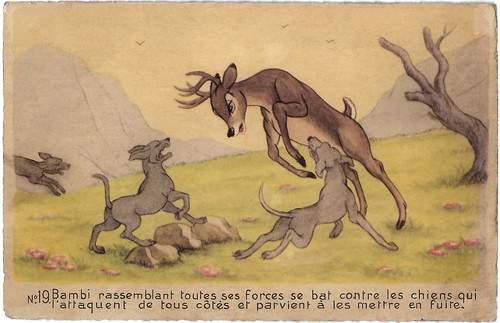
French postcard by Editions Superluxe, Paris, no. 19. Image: Walt Disney Mickey Mouse S.A.. Publicity still for Bambi (1942). Caption: Bambi gathering all his forces fights against the dogs that attack him from all sides and manages to put them to flight.

French postcard by Editions Superluxe, Paris, no. 21. Image: Walt Disney - Mickey Mouse S.A.. Publicity still for Bambi (1942). Caption: 'Alerted, the Big Deer, King of the Forest, observes the camp of these men who, in the past, took him the mother of Bambi."
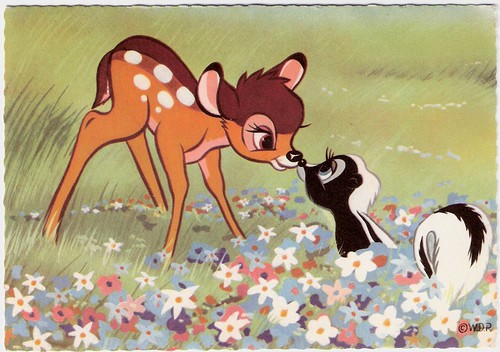
German postcard by Hansa-Verlagsanstalt, Bonn. Image: Walt Disney Productions. Publicity still for Bambi (David Hand, 1942).
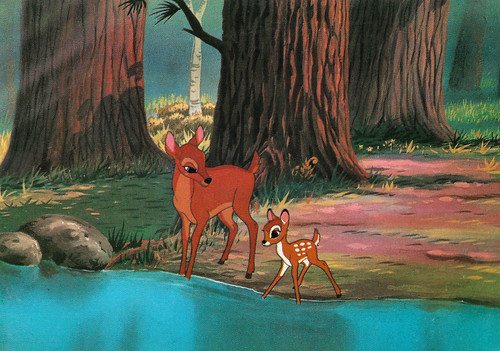
Italian postcard by Grafiche Biondetti, Verona, no. 101. Image: Walt Disney Productions. Publicity still for Bambi (David Hand, 1942). Sent by mail in 1969.

Italian postcard by Grafiche Biondetti, Verona, no. 101. Image: Walt Disney Productions. Publicity still for Bambi (David Hand, 1942).
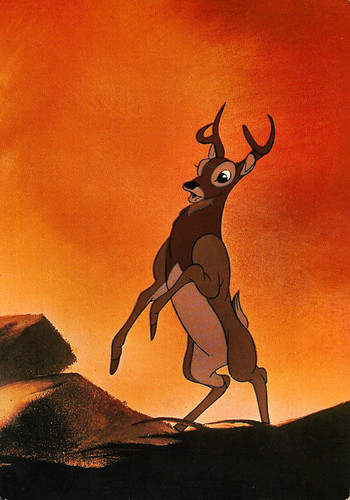
Italian postcard by Grafiche Biondetti, Verona, no. 101. Image: Walt Disney Productions. Publicity still for Bambi (David Hand, 1942).
Sources: Hal Erickson (AllMovie), Wikipedia and IMDb.

Dutch postcard by Rembrandt Uitg. Mij. Amsterdam, circa 1949. Image: publicity still for Bambi (1942). Caption: "Deep in a dark green forest, Prince Bambi is born."

Dutch postcard by Rembrandt Uitg. Mij. Amsterdam, circa 1949. Image: publicity still for Bambi (1942). Caption: "All the animals of the forest want to see the young Prince Bambi."

Dutch postcard by Rembrandt Uitg. Mij. Amsterdam, circa 1949. Image: Walt Disney Mickey Mouse Ltd. Publicity still for Bambi (1942). Caption: "'He can already walk!', calls Thumper, the rabbit."

Dutch postcard by Rembrandt Uitg. Mij. Amsterdam, circa 1949. Image: publicity still for Bambi (1942). Caption: "Little Thumper, what did your father say?", asks Mother Rabbit."

Dutch postcard by Rembrandt Uitg. Mij. Amsterdam, circa 1949. Image: publicity still for Bambi (1942). Caption: "Eat as many vegetables as you can, Thumper says to Bambi."
If this moment doesn't move you to tears, you're made of stone
The main characters of Bambi (David Hand, 1942) are Bambi, a mule deer and his parents, the Great Prince of the forest and his unnamed mother. His friends are Thumper, a pink-nosed rabbit; and Flower, a skunk. and his childhood friend and future mate, Faline.
For the film, Disney took the liberty of changing Bambi's species into a mule deer from his original species of roe deer, since roe deer are not native to North America, and the mule deer is more widespread in the United States.
English film historian Leslie Halliwell wrote that Bambi was "one of Disney's most memorable and brilliant achievements with a great comic character in Thumper and a climactic forest fire sequence that is genuinely thrilling". He concluded his review that it was "a triumph of the animator's arts".
Hal Erickson at AllMovie adds: "In the grand Disney tradition, Bambi is brimming with unforgettable sequences, notably the young deer's attempts to negotiate an iced-over pond, and most especially the death of Bambi's mother - and if this moment doesn't move you to tears, you're made of stone (many subsequent Disney films, including Lion King, have tried, most in vain, to match the horror and pathos of this one scene).
The score in Bambi yielded no hits along the lines of 'Whistle While You Work', but the songs are adroitly integrated into the action. Bambi was the last of the 'classic' early Disney features before the studio went into a decade-long doldrums of disjointed animated pastiches like Make Mine Music."

Dutch postcard by Rembrandt Uitg. Mij. Amsterdam, circa 1949. Image: Walt Disney Mickey Mouse Ltd. Publicity still for Bambi (1942). Caption: "The rabbit friends learn Bambi how to jump."

Dutch postcard by Rembrandt Uitg. Mij. Amsterdam, circa 1949. Image: publicity still for Bambi (1942). Caption: "'What a strange beasts!', Bambi thinks."

Dutch postcard by Rembrandt Uitg. Mij. Amsterdam, circa 1949. Image: publicity still for Bambi (1942). Caption: "Quietly, a butterfly lands on Bambi's tail."

Dutch postcard by Rembrandt Uitg. Mij. Amsterdam, circa 1949. Image: Walt Disney - Mickey Mouse Co. Publicity still for Bambi (1942). Caption: "Splash... what a pound of snow!", Bambi thinks.

Dutch postcard by Rembrandt Uitg. Mij. Amsterdam, circa 1949. Image: publicity still for Bambi (1942). Caption: "Smooth Ice, huh!", says Thumper. "I'll get your legs out of the knot..."

Dutch postcard by Rembrandt Uitg. Mij. Amsterdam, circa 1949. Image: Walt Disney Mickey Mouse Ltd. Publicity still for Bambi (1942). Caption: "'You don't have to be afraid, Bambi!', says Feline, the deer girl."
Artwork that did not necessarily look like the forest but felt like it
Chinese-American artist Tyrus Wong (1910-2016) was the creator of the visual style of Bambi (1942). Wong, newly married and needing steady work, joined Disney in 1938 as an 'in-betweener'. He draw hundreds of pictures between poses to create the illusion of motion.
When Walt Disney began pre-production on Bambi, Wong went home and painted several pictures of a deer in a forest. Disney saw that Wong was able to produce artwork that did not necessarily look like the forest - but rather, felt like the forest.
As a staff artist for Hollywood studios from the 1930s to the 1960s, Wong drew storyboards and made vibrant paintings, as detailed as any architectural illustrations, that helped the director envision each scene before it was shot. For Bambi, he was involved with every phase of production.
Margalit Fox in The New York Times: "Invoking the exquisite landscape paintings of the Song dynasty (A.D. 960–1279), he rendered in watercolors and pastels a series of nature scenes that were moody, lyrical and atmospheric — at once lush and spare — with backgrounds subtly suggested by a stroke or two of the brush."
Tyrus Wong only worked at Disney for three years, as a consequence of the Disney animators' strike. He moved to Warner Brothers as a concept artist, designing greeting cards for Hallmark on the side. Over the years his work informed the look live-action films for Warner Brothers and other studios.
In a statement after his death in 2016, the Walt Disney Family Museum said "his influence on the artistic composition of the animated feature Bambi cannot be overstated."

French postcard by Editions Superluxe, Paris, no. 4. Image: Walt Disney - Mickey Mouse S.A.. Publicity still for Bambi (1942). Caption: Bambi, encouraged by his friend Thumper, tries to jump over a tree trunk, but his paws are still too weak.

French postcard by Editions Superluxe, Paris, no. 19. Image: Walt Disney Mickey Mouse S.A.. Publicity still for Bambi (1942). Caption: Bambi gathering all his forces fights against the dogs that attack him from all sides and manages to put them to flight.

French postcard by Editions Superluxe, Paris, no. 21. Image: Walt Disney - Mickey Mouse S.A.. Publicity still for Bambi (1942). Caption: 'Alerted, the Big Deer, King of the Forest, observes the camp of these men who, in the past, took him the mother of Bambi."

German postcard by Hansa-Verlagsanstalt, Bonn. Image: Walt Disney Productions. Publicity still for Bambi (David Hand, 1942).

Italian postcard by Grafiche Biondetti, Verona, no. 101. Image: Walt Disney Productions. Publicity still for Bambi (David Hand, 1942). Sent by mail in 1969.

Italian postcard by Grafiche Biondetti, Verona, no. 101. Image: Walt Disney Productions. Publicity still for Bambi (David Hand, 1942).

Italian postcard by Grafiche Biondetti, Verona, no. 101. Image: Walt Disney Productions. Publicity still for Bambi (David Hand, 1942).
Sources: Hal Erickson (AllMovie), Wikipedia and IMDb.
Wonderful post!
ReplyDelete